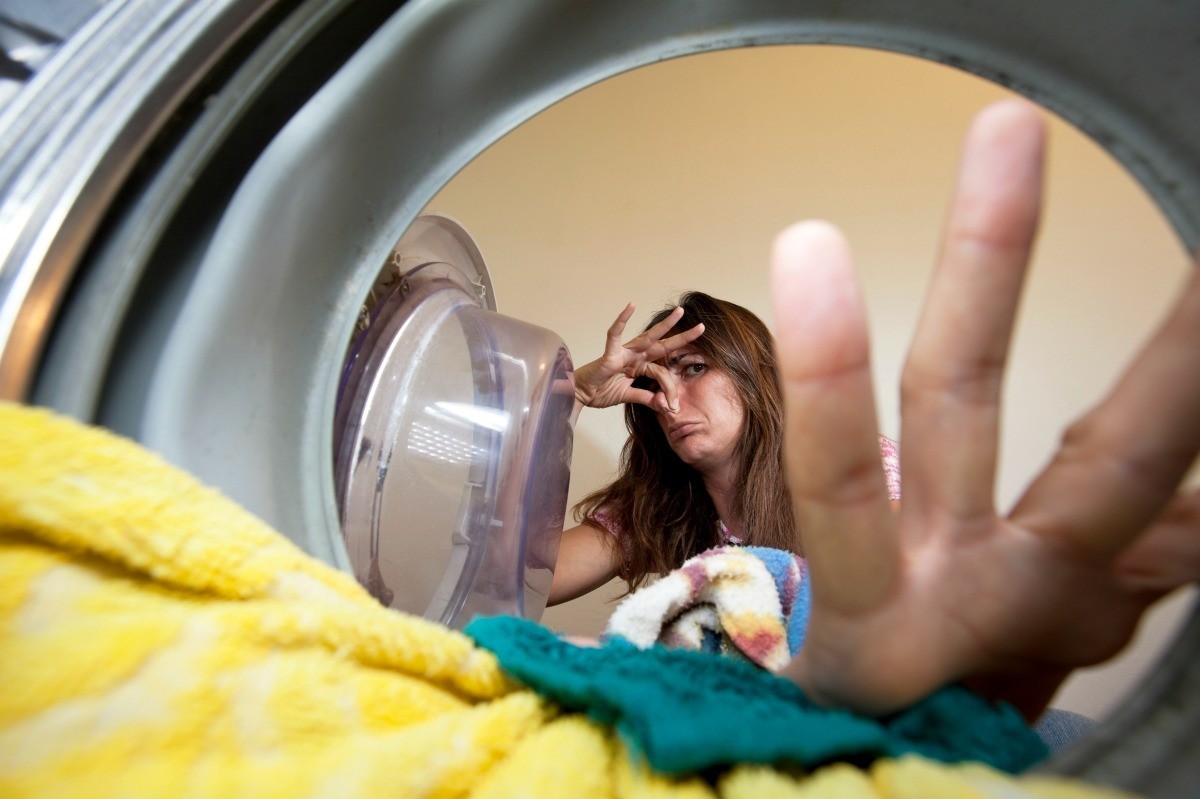You rely on your washing machine to keep your clothes clean and smelling fresh. But what happens when your washing machine itself is the source of stains and bad smells on your clothing? Whatever type of washing machine you have, this ultimate guide will show you how to identify signs that your washing machine needs cleaning, and how to clean your washing machine for the best results.
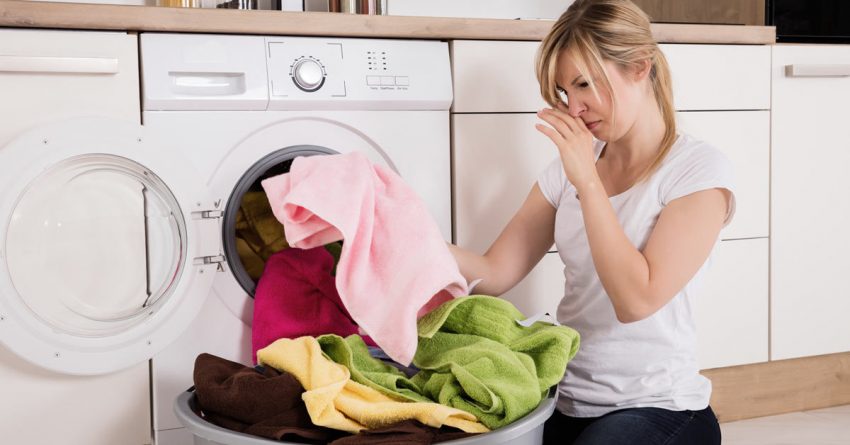
Signs your washing machine needs cleaning
How to clean a washing machine that smells
Noticed a stale, musty smell on your clothes? Or even the smell of eggs or sulfur? A bad smell is usually the first indication your washer needs a good scrub. Over time bacteria, limescale, soap scum, slime, and mildew can all accumulate inside your washing machine, preventing your washer from working efficiently and leaving your clothes dirtier than when you put them in there.
While the idea of mold and bacteria hanging out in your washer is gross, it shouldn’t be surprising. Washing machines are the sort of warm, dark, wet environments that microorganisms love. They even get fed with regular doses of laundry detergent. Yep, soap scum isn’t just unsightly, it’s a banquet for bacteria.
A musty or mildew smell indicates mold is growing inside your washer. Search for it around the rubber gasket of front loader machines.
If you smell eggs, sulfur, or sewage, you’ve probably got bacteria inside your washing machine. The smell comes from hydrogen sulfide gas, a byproduct of bacteria metabolism.
It isn’t only the smells that give away a problem with your washing machine. Slow draining could be a sign that soap scum and lint are building up in the drain. Regularly cleaning your washing machine filter and flushing the drain will help your washer smell better and run more efficiently.
You might also see visible signs of dirt and grime accumulation. If your washer is dirty, so are your clothes, and sometimes they’ll have black or rusty marks on them after they’ve been through a cycle.
Whether or not you notice any obvious signs your washing machine is due to be cleaned, it’s always a good idea to clean your washer on a regular schedule in order to prevent dirt, mold, or soap scum from becoming a problem. Read on to find out the best way to clean your washing machine.
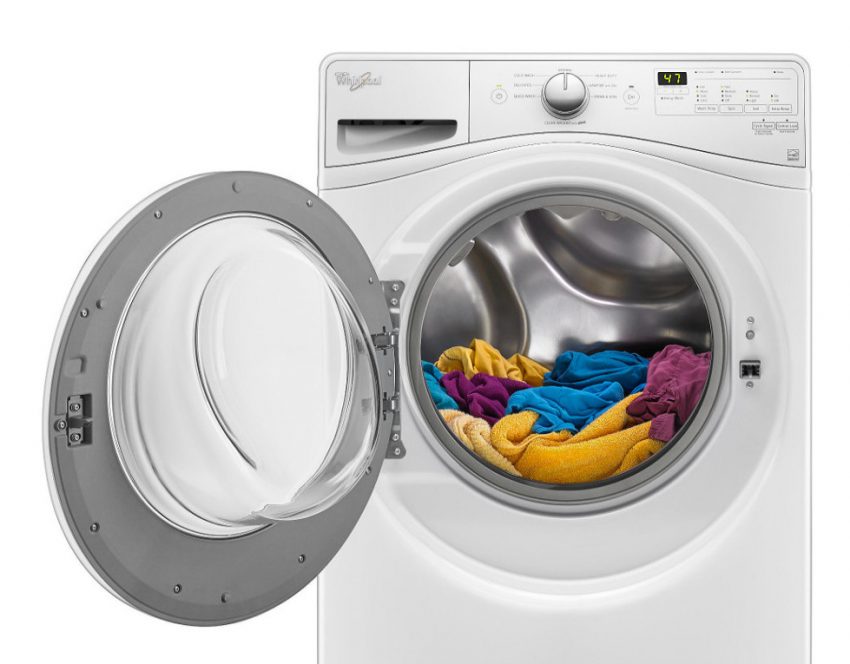
Cleaning tips for front loader washing machines
How to clean a washing machine front loader
Front loaders are the most common type of washing machine, but they are also at most risk of mold growth because of their door design. The rubber gasket around the door creates the perfect environment for mold to grow because it’s dark and damp. The folds in the rubber that create the door seal provide hiding places where you might not notice mold is accumulating until it’s already established.
It’s a good idea to check around the door of your front loader once a week as part of your usual cleaning routine. Pull back the rubber to inspect between the folds and give it a quick wipe down with a rubber-safe, antibacterial cleaner. If you see black marks on your cleaning utensils, that’s an indication that mold and mildew are growing inside the machine.
To further help dry out your washer between loads, use a microfiber cloth to wick away any moisture around the door and basket (or drum). Microfiber is best for this because it’s highly absorbent and doesn’t leave lint behind.
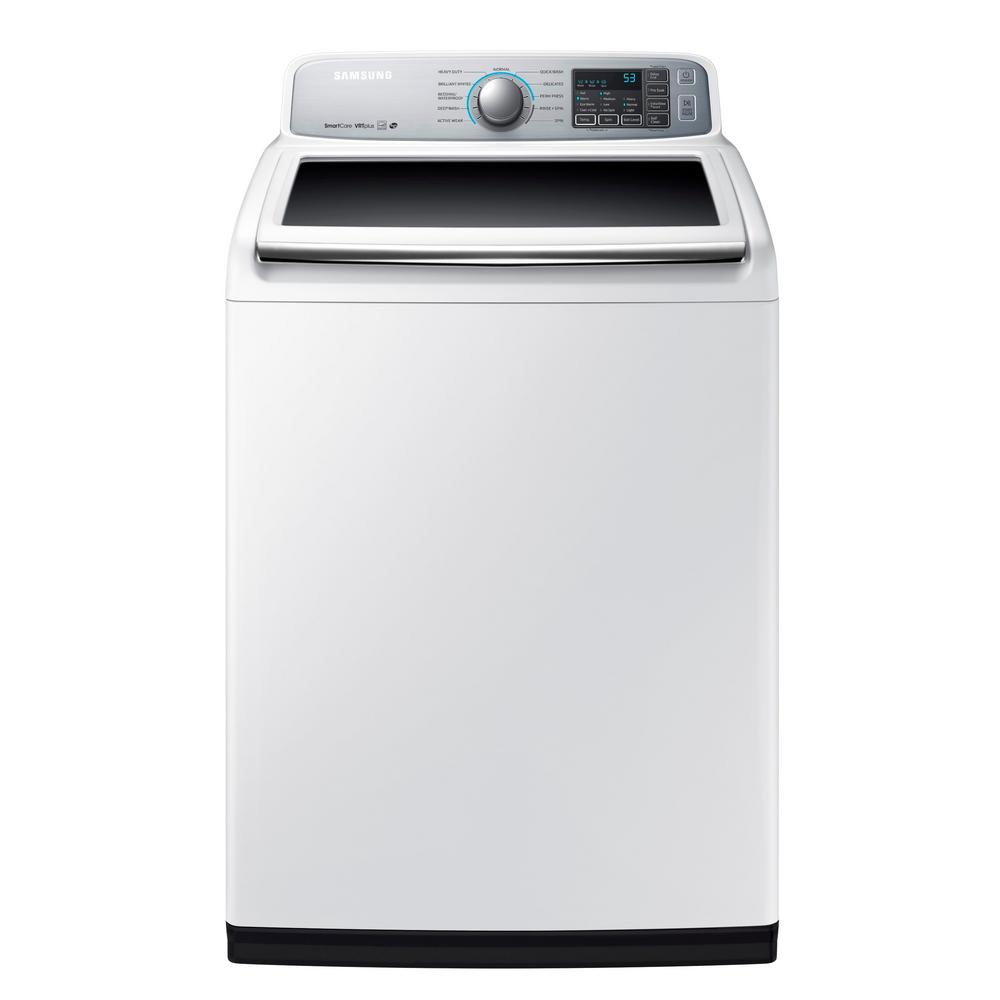
Cleaning tips for top loader washing machines
How to clean a washing machine top loader
Top loader washing machines don’t have the same problem with mildew in the door gasket that front loaders are prone to, but they still need regular cleaning and maintenance to ensure they’re working efficiently. Water and soap can pool in the bottom of top loaders, leaving a musty smell behind that permeates your clothes on the next wash. Too much soap accumulation can also cause top loaders to drain slowly, and a lot of new top loaders don’t fill the drum all the way with water. That can mean large areas get damp through steam and splashing but are never submerged and properly cleaned.
What products clean a washing machine
Whatever type of washing machine you own, taking care of it with regular cleaning will ensure you get the best performance and truly clean clothes from every wash.
SYMPTOM |
CAUSE |
TREATMENT |
Musty smell |
Mold or mildew growth |
Clean drum and gasket with all-purpose cleaner |
Egg/sulfur/drains smell |
Bacteria growth |
Clean with a disinfectant such as bleach |
Slow draining |
Soap scum buildup in pipes |
Run a hot wash with a grease-busting cleaner |
Smelly clothes |
Mold or mildew growth |
Run a hot wash with an antibacterial cleaner |
Stained or dirty clothes |
Mold or bacteria growth
|
Use bleach to kill bacteria and stay on top of future growth |
How to clean a washing machine with bleach
How to sanitize a washing machine with bleach
Note: Whenever using bleach, take care not to mix it with other chemicals, particularly ammonia. The reaction can create fumes that are irritating or harmful when breathed in. Try to open a window and use gloves when working with bleach in order to stay safe.
Chlorine bleach is a cleaner’s best friend when it comes to killing mold and mildew and sanitizing surfaces. Using bleach, you can quickly and efficiently clean and sanitize your washing machine.
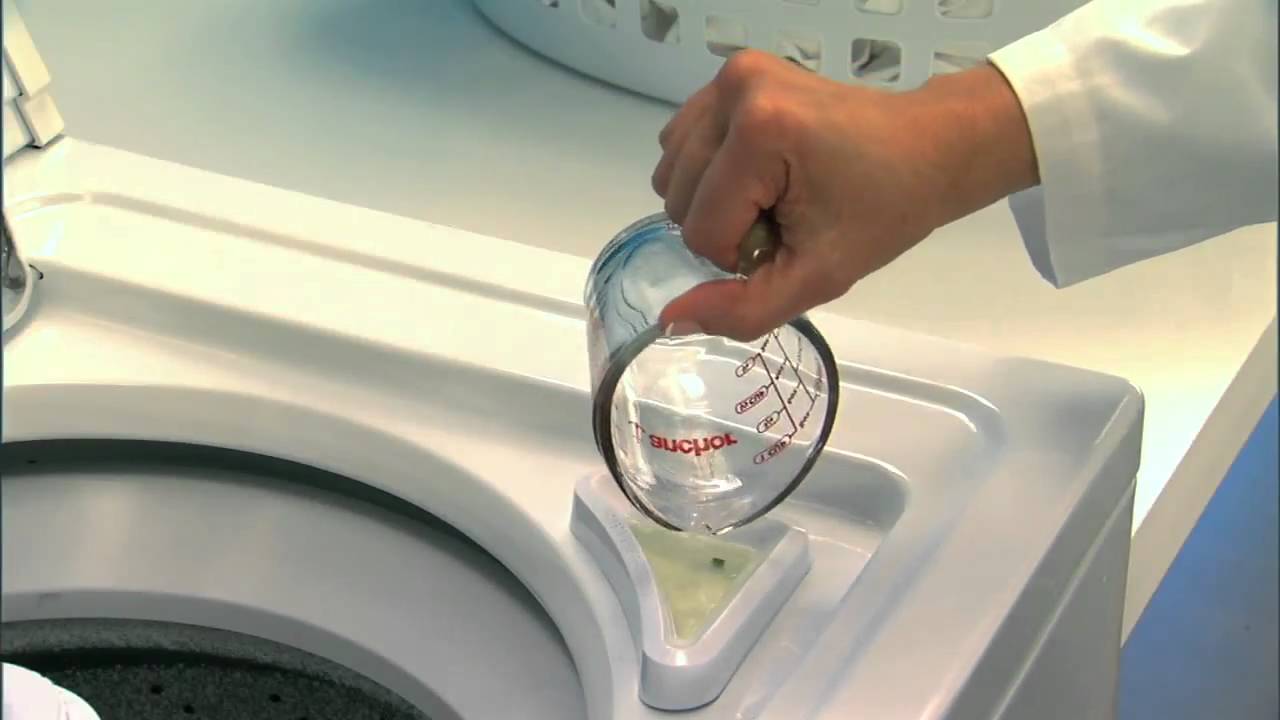
Cleaning a front loader washing machine with bleach
Step 1: Set your washing machine on the highest temperature it will go.
Step 2: Pour two cups of bleach into the detergent tray.
Step 3: Set your washing machine to run on the longest cycle.
Step 4: Allow the cycle to start, the basket to fill, and the bleach to mix with the water.
Step 5: Pause the cycle and let the bleach and water sit inside the basket for half an hour.
Step 6: Resume the cycle and let it finish.
Cleaning a top loader washing machine with bleach
Cleaning a top loader washing machine with bleach is a very similar process. If your top loader has a detergent drawer, add two cups of bleach, and put another two cups into the drum. If you don’t have a drawer, just add four cups of bleach to the drum. Start the longest, hottest cycle and let the agitator mix the bleach with the water. Then pause the cycle and let the machine sit for half an hour, before restarting and completing the cycle.
Cleaning your washing machine if you can’t pause the cycle
If your washing machine doesn’t allow you to pause the cycle, or you don’t have time to keep an eye on it, you can skip this step by putting the bleach directly into the basket and allowing it to sit for an hour before turning the washer on.
Removing the smell of bleach from your washing machine
Bleach is a highly efficient cleaner that will get your washer sparkling clean, but it doesn’t smell great on your clothes. In order to remove any lingering traces, run the washing machine again on a rinse cycle to flush out the last of the bleach.
Pro Tip: If you don’t like using bleach, but you want the same bacteria-killing power, you can substitute chlorine bleach for an equal amount of hydrogen peroxide instead. Either solution is suitable to sanitize your washing machine.
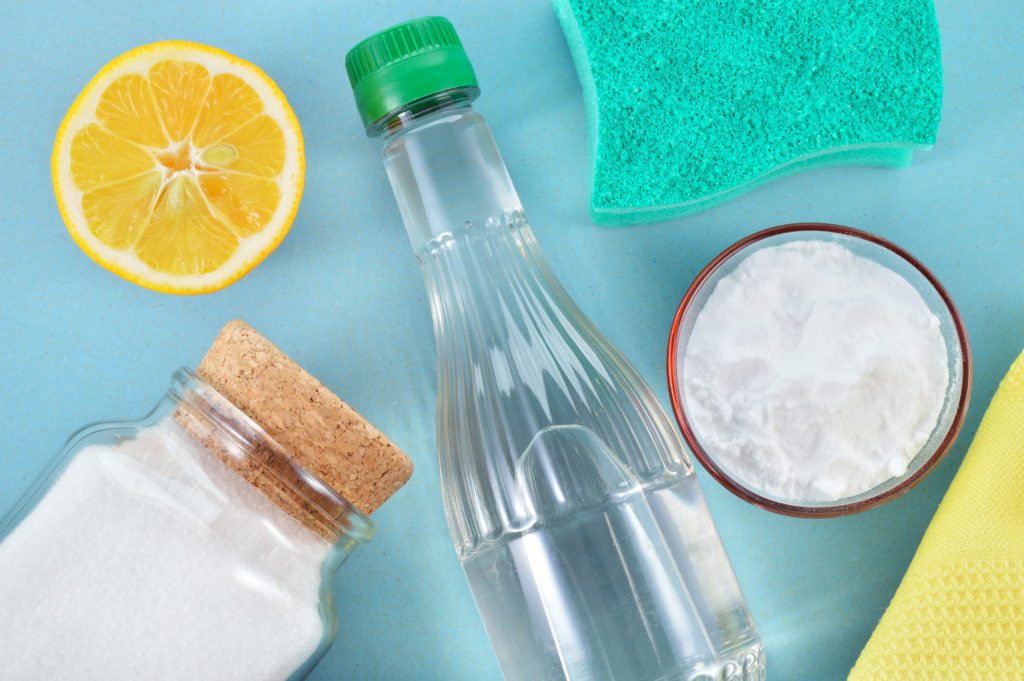
How to clean a washing machine with vinegar and baking soda (sodium bicarbonate)
If a DIY washing machine cleaner is more your style, you can’t go wrong with white vinegar and baking soda, also known as sodium bicarbonate. The combination makes an effective cleaner for almost any surface or appliance. The cleaning and antibacterial properties of vinegar make it a prized cleaning solution. Combining acidic vinegar with a weak base such as baking soda makes a powerful foaming cleaner that blasts away dirt.
Pro Tip: Always use plain white or distilled vinegar inside your washing machine, not any other kind. While all sorts of vinegars are useful for cleaning, they can leave a residue behind. White vinegar is a great deodorizer so don’t worry about any lingering smell after you use it.
What You’ll Need
- White/distilled vinegar
- Baking soda
- Fresh water (optional)
- Lemon juice (optional)
Cleaning a front loader washing machine with vinegar and baking soda
You can add vinegar and baking soda to your front loader washing machine in a number of ways, but to get the most effective cleaning results, you don’t want the two to mix until they’re in the basket, where they’re most needed. Try any of the following:
- Add 2 cups of vinegar to the detergent dispenser, and half a cup of baking soda to the softener dispenser.
- Put 2 cups of vinegar directly into the drum of the machine. Mix enough water with half a cup of baking soda to make a loose paste and put it into the detergent dispenser.
- Add vinegar and baking soda directly into the basket.
- Add half a cup of baking soda to the drum, start the cycle, and then pour 2 cups of vinegar into the detergent dispenser.
Once your vinegar and baking soda have been added to your washer, begin a long, hot cycle. As soon as the basket has filled and the baking soda and vinegar have mixed together, pause the cycle and let it sit for half an hour in order to soak and allow the solution to get to work on cleaning the machine. Then resume the cycle to make your washer fresh and clean.
Cleaning a top loader washing machine with vinegar and baking soda
Most top loaders don’t have detergent drawers, so you’ll have to combine the vinegar and baking soda inside the drum. Use four cups of white or distilled vinegar to clean your top loader. There are several ways of adding the vinegar and baking soda to your machine:
- Add 4 cups of vinegar and 1 cup of baking soda to the basket and start a long, hot cycle. If possible, pause the cycle for half an hour after the basket has filled.
- Fill the drum with hot water and add 4 cups of vinegar. Let stand for half an hour, then add 1 cup of baking soda and run a long, hot cycle immediately.
- Put 1 cup of baking soda into the washer and start a long, hot cycle. Let the agitator mix the baking soda into the water until it has dissolved (about 10 minutes). Pause the cycle and add 4 cups of vinegar to the hot water. Allow the mixture to sit for half an hour before resuming the cycle.
Pro Tip: Instead of vinegar, you can get the same results—and a fresher scent—by using lemon juice. Simply replace the white vinegar with the same amount of real lemon juice. Just be careful there’s no extra sugar or other additives that will leave a residue in your washer.
Vinegar and baking soda make a great cleaner for washing machines because they remove hard water deposits as well as dirt and grime. Instead of lemon juice, you can also substitute the vinegar for equal amounts of citric acid or hydrogen peroxide.
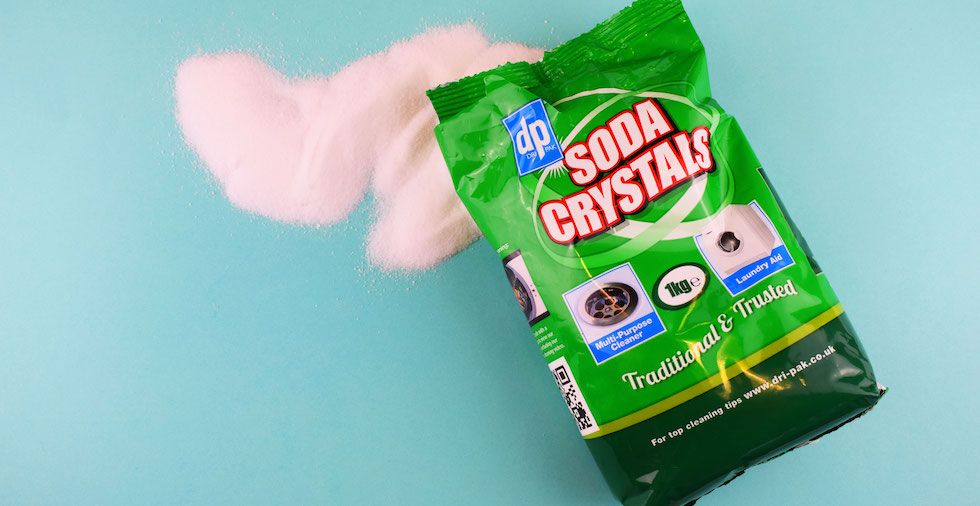
How to clean a washing machine with soda crystals
Soda crystals, sometimes called washing soda, are a form of sodium carbonate that’s a powerful water softener and multipurpose cleaner. They’re particularly effective at dissolving grease, which makes soda crystals a great cleaner for your washing machine because they can break down the soap scum that blocks drains and encourages bacteria to grow.
Place two cups of soda crystals into your washing machine drum and start a long, hot wash. Soda crystals dissolve in hot water so that’s all you need to do to activate their cleaning power. You can repeat this every month or so as a maintenance cleaning cycle in order to keep your washing machine in top condition.
Pro Tip: To clean your detergent tray, add half a cup of soda crystals to two cups of hot water and stir until dissolved. Pour the solution into the dispenser drawer before starting your cleaning cycle in order to flush soap residue out of the drawer and pipes.
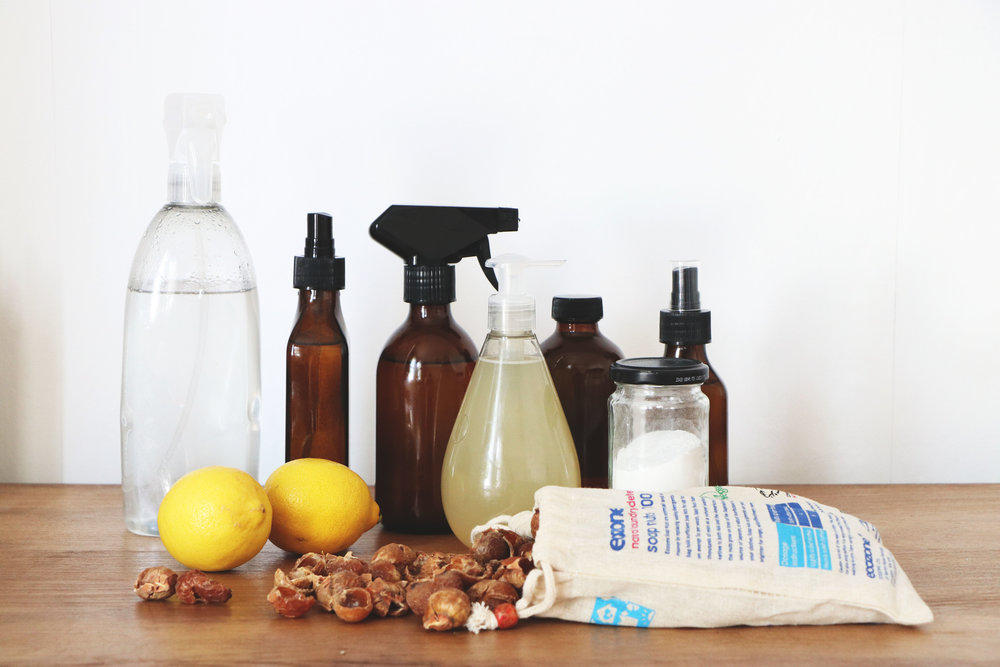
The best DIY and natural cleaning solutions for washing machines
How to clean a washing machine naturally and what to use
You don’t need a lot of specialist solutions or harmful chemicals in order to clean your washing machine. You can always use one of these DIY solutions and stick to natural ingredients to make a cheap, effective, eco-friendly cleaner for your washer.
You can use all of these suggestions as topical solutions by filling a spray bottle and spritzing your washer. Wipe clean with a microfiber cloth. You can also add two cups of solution to a front loader, or four cups to a top loader washing machine as a general cleaner.
Hydrogen peroxide and lemon juice
- 2 cups water
- Half cup hydrogen peroxide
- Quarter cup real lemon juice
Hydrogen peroxide and lemon juice are the active ingredients in this solution. They’re both effective cleaners that combat and inhibit mold growth.
Vinegar and lemon juice
- 2 cups water
- Half cup white vinegar
- Quarter cup real lemon juice
What to clean a smelly washing machine with
For a more natural alternative to hydrogen peroxide, you can always use distilled white vinegar as an all-purpose cleaner. Despite its strong smell, white vinegar is a great deodorizer, so combined with the lemon juice it will leave your washing machine smelling fresh and clean.
White vinegar
- 1 cup distilled white vinegar
- 4 cups water
Just diluted vinegar is enough to make an effective cleaner for your washing machine. Vinegar inhibits mold growth and deodorizes.
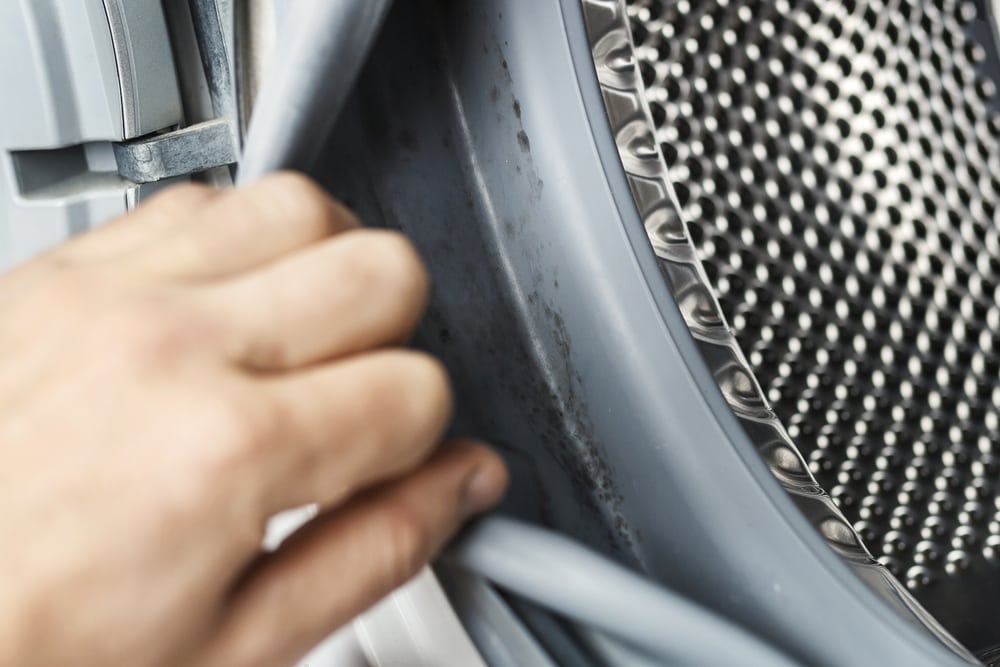
How to sanitize a washing machine to get rid of mold and bacteria
If you’ve tried everything else, it might be time to resort to bleach in order to keep mold and bacteria under control in your washing machine. A dilute mixture of bleach and water makes a good, all-purpose solution that you can use to sanitize your washer.
Bleach
- 1 cup chlorine bleach
- 4 cups water
Pro Tip: For a really fresh smelling washing machine, add a tablespoon of eucalyptus oil to the water of a hot wash. The oil doesn’t just make the washer smell great, it can also break down soap deposits in your drain. You can use eucalyptus oil on its own, or with white vinegar and baking soda to clean your washing machine.
How to clean the different parts of your washing machine
Depending on if you have a front or top loader washer, there are different parts of your machine that will need more attention in order to keep clean. Front loaders are prone to mold and mildew growth in the folds of the rubber gasket around the door, while top loaders can get musty if water starts to drain slowly and pool in the bottom of the basket. Knowing which parts to keep an eye on, and how best to clean them, will make keeping your washing machine in top condition a breeze.
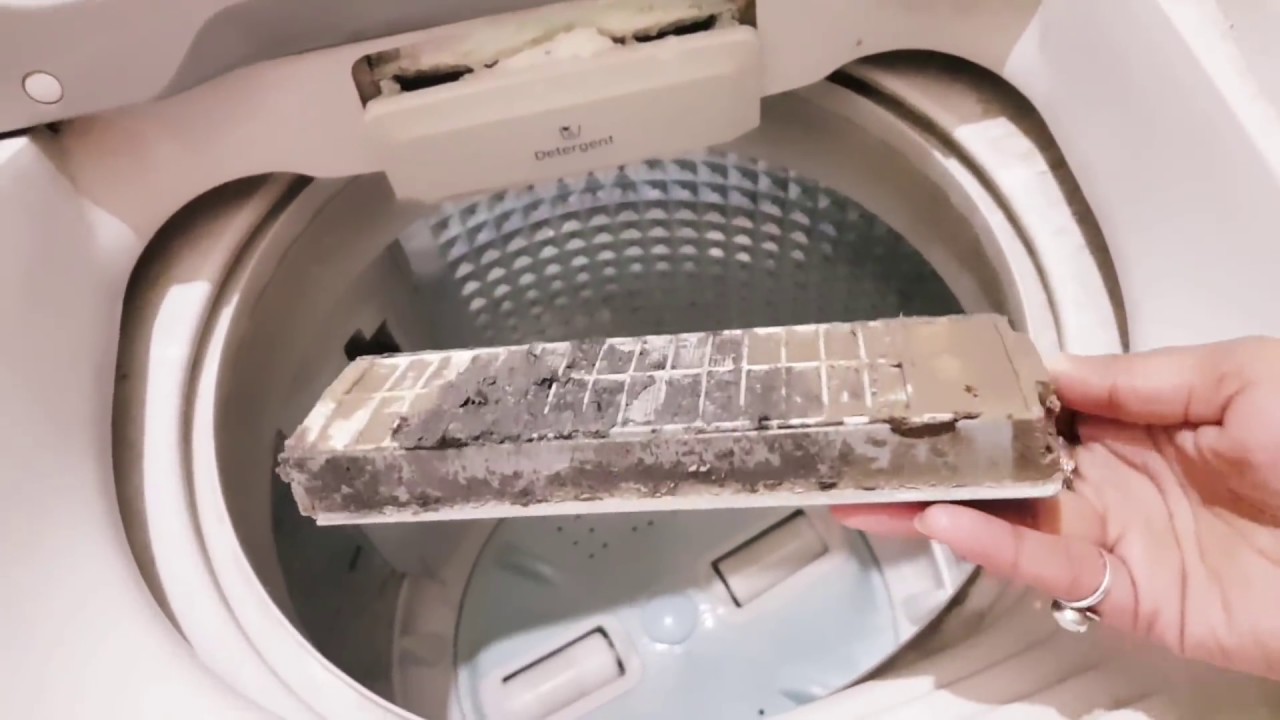
How to clean a washing machine gasket and filter
How to clean a washing machine drum inside
Both front or top loader washing machines can start to smell if the drum isn’t clean. Modern machines often use only a small amount of water in the tub, so they don’t automatically get cleaned when you run a load of laundry.
The best way to clean the drum is to run a hot wash using a cleaner such as bleach, vinegar, soda crystals, or one of the DIY cleaning solutions listed above. Once the wash cycle has finished, wipe down the basket with a microfiber cloth to wick up any water residue.
Front loader washing machine filters are usually located at the lower front of the machine. For top loaders, the filter is normally inside the fabric softener dispenser, on top of the agitator inside the basket.
Locate your filter and take it out. Front loaders usually require a screwdriver or coin to open the access door. With top loaders, the dispenser will usually unscrew from the top of the agitator. Bear in mind that there’s usually water inside the filter, so put down an old towel to catch any drips.
Remove any debris that has collected in the filter. This could include keys, coins, and lint, as well as sharp objects such as pins, so be careful. Once emptied, run the filter under water and give it a scrub with an old toothbrush if it’s very dirty.
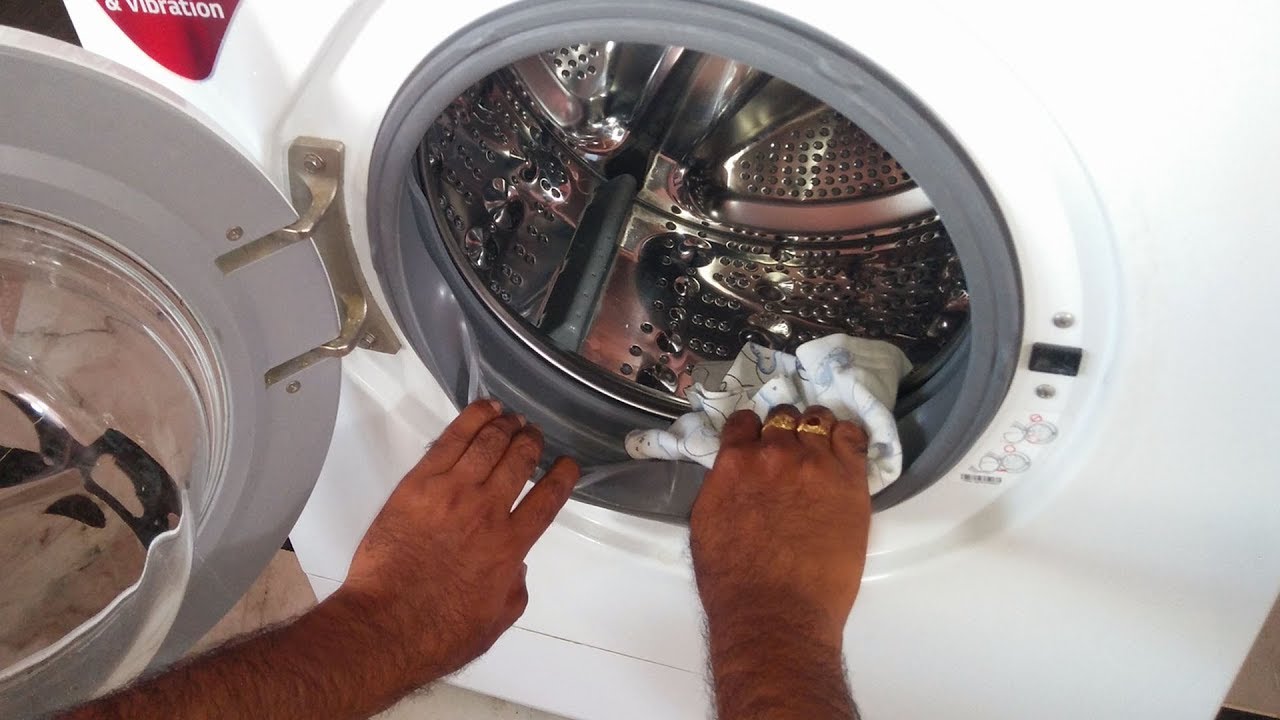
How to clean a washing machine gasket
What to clean washing machine seal with and how to clean it
The gasket is the rubber seal around the door of front loader washing machines. Gaskets are prone to mold and mildew because they offer a warm, dark, moist environment. To check for dirt, pull apart the rubber folds and run a clean microfiber cloth around the gasket. If it comes away green, brown, or black, there’s mold and mildew growing.
How to sanitize a washing machine gasket
To clean and sanitize your washing machine gasket, spray a microfiber cloth with a topical cleaning solution such as white vinegar, all-purpose cleaner, or bleach, and wipe the gasket clean, paying particular attention to the areas where it folds and/or water pools. If you can’t reach all the way around the gasket, or it has a lot of accumulation, use a soft-bristled brush to gently scrub away dirt.
For the best long-term results, dry the gasket after every wash and leave the door ajar to help water evaporate.
How to clean a washing machine soap dispenser
What to clean washing machine drawer with and how to clean it
Dispenser drawers quickly accumulate soap scum that looks unsightly and can lead to blockages. Most washing machine dispenser trays are removable, so you should be able to slide out the entire unit. Remove all the parts you can and wipe away as much soap and residue as possible with a paper towel.
Place the tray and drawers into a bucket of warm, soapy water and let them soak for half an hour. You should then be able to clean them easily with a sponge or microfiber cloth. An old toothbrush can come in handy for getting to hard-to-reach corners.
Dry all the parts thoroughly before reassembling them and putting them back into your washing machine.
How to maintain your washing machine with regular cleaning
How to sanitize a washing machine during regular cleaning
An ounce of prevention is better than a pound of cure and cleaning your washing machine as part of your normal routine will help keep it in prime condition and prevent odors or stains on your clothes.
Pro Tip: Many washing machines come with a preset cleaning cycle, so consult your user manual.
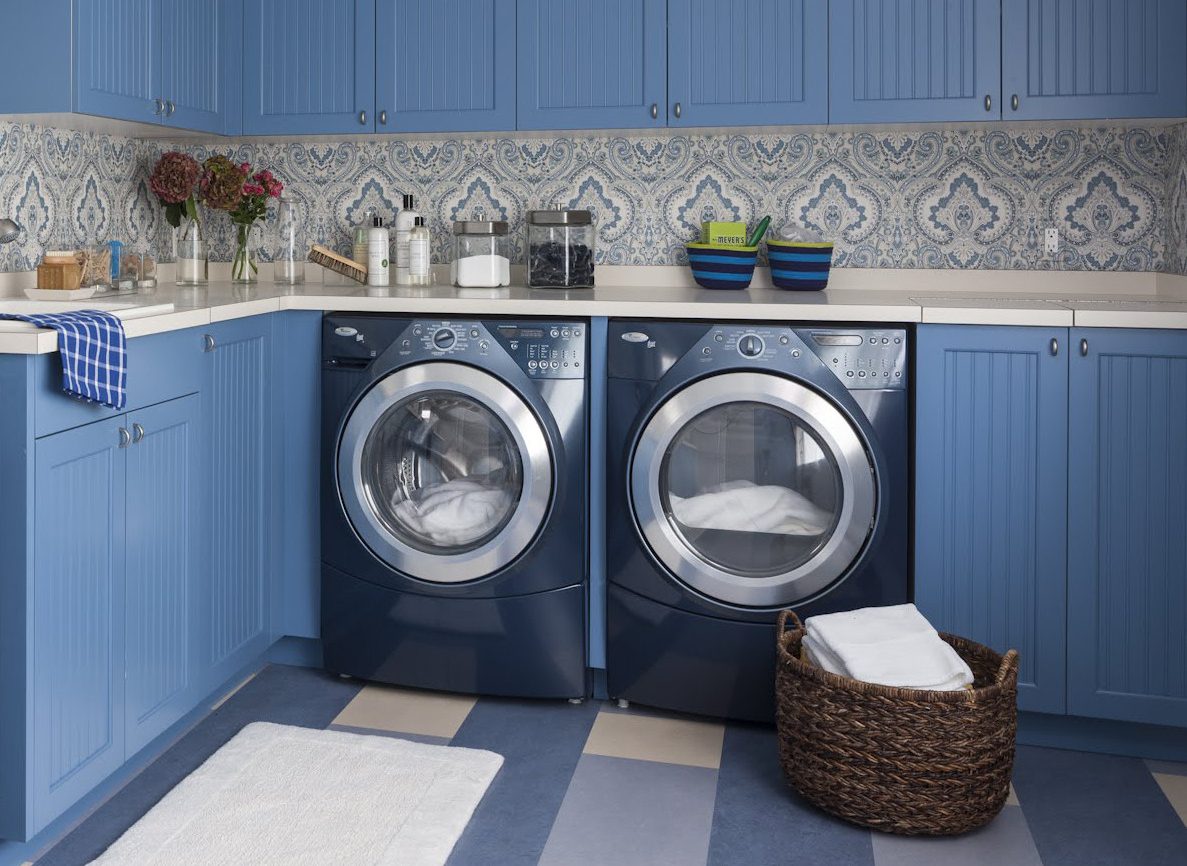
Once a month, run your washing machine on a hot cycle with a cleaning solution in order to sanitize the drum and flush the pipes. You can use bleach, vinegar, soda crystals, or any of the DIY solutions we’ve recommended, or purchase a specialist washing machine cleaner.
Use the right laundry detergent in your washing machine. High efficiency (HE) washers need high efficiency detergent, otherwise they will create too many suds. This leads to a buildup of residue and soap scum that can cause smells, blockages, and bacteria growth inside your washing machine. If you have been using the wrong detergent, a couple of hot rinse cycles should clean out the pipes.
Don’t leave wet clothes in your washing machine. We’re all guilty of this sometimes, but damp clothes contribute to a moist atmosphere where microorganisms can flourish. Moving your clothes immediately also prevents them from getting musty and needing to be washed again.
Leave the door open. This allows air to circulate, preventing your machine from being overrun with mold and mildew. Most new washing machines have a latch called a magnetic door plunger or holder that props the door open about an inch in order to allow it to dry. You can also buy aftermarket latches that do the same job for older machines.
If your laundry room is particularly prone to being humid, use a dehumidifier to strip some of the moisture from the air. The drier you can keep your washing machine, the longer it will last.
That’s all there is to it! With regular cleaning and a little TLC, your washing machine can be as clean and efficient for years to come.
Source link



